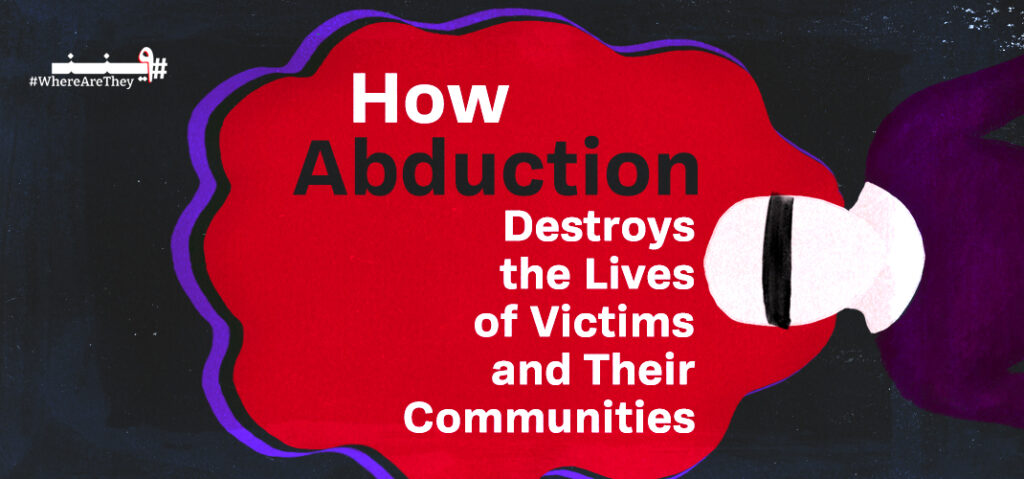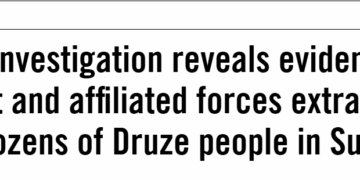Ola Al-Jari
Since the fall of the Syrian regime on December 8, 2024, Syria has entered a turbulent transitional phase that quickly turned into a new arena of chaos and uncontrolled violence. While Syrians’ hopes were pinned on building a state of law and justice, women in particular found themselves at the heart of a new struggle—one in which their bodies are used as tools of pressure and bargaining.
Starting in February 2025, reports began to surface about a wave of kidnappings targeting Alawite women in sensitive sectarian frontlines such as Homs and its countryside, then the rural areas of Hama and the Syrian coast. These abductions occurred in vengeful contexts fueled by sectarian motives and political interests, turning women into instruments of extortion and domination. The incidents escalated following the bloody massacres that struck members of the Alawite community in the Syrian coast from early March onward.
In July, a new chapter of abductions began with the kidnapping of Druze women following the invasion of Suwayda Province in southern Syria by the transitional authority’s forces and allied militias—a repetition of the same pattern of using women as a means of subjugation, a message of collective humiliation, and a negotiation card to pressure political rivals.
Kidnapping is no longer an isolated criminal act; it has become a political strategy used by the authorities against specific communities, aimed at breaking their social fabric and reproducing fear in its most violent and painful forms.
The regime’s involvement is evident through its policy of denial and obfuscation, along with the direct or indirect participation of individuals affiliated with it. According to international reports, members of the Ministries of Interior and Defense have been involved in or covered up acts of abduction and detention. Meanwhile, official institutions and state media adopted a discourse that denies the crime and blames the victims instead of protecting them.
In this context, the Interior Ministry’s statement issued last week stands as an official document that incriminates the transitional authority and exposes its entanglement in these crimes. The report presented the findings of a so-called investigation committee—formed by the very ministry whose members are accused of the kidnappings—conducted in an unprofessional and unlawful manner that calls any of its conclusions into question. The committee claimed that out of 42 cases it investigated, 41 were “unfounded,” alleging that the women in question had either “run away with romantic partners, were involved in prostitution, or had family disputes.” It recognized only one case as legitimate, in which the victim was returned to her family—without disclosing the identity of the kidnappers or announcing any accountability measures.
Thus, the transitional authority has not only failed to protect women but has also adopted a narrative that blames victims and absolves perpetrators, reproducing the same justifications once used by Bashar al-Assad’s regime to cover up violations—by questioning the testimonies of victims and their families and diluting the issue through a systematic media campaign that grows more aggressive whenever activists or women’s rights advocates attempt to raise their voices and shed light on the ongoing crime.
These practices reveal the structural fragility of the governing institutions and the persistence of a culture of impunity that emboldens perpetrators to continue their crimes. They also show how the female body is politicized and weaponized as a symbol in the struggle for control and dominance—especially in a conservative society like Syria, where the impact of kidnapping extends far beyond the physical and psychological harm of the victim to become a lasting social stigma that marks the lives of victims and their families forever. Sexual violations that often accompany abductions are treated as taboos, and women are frequently blamed for the violence inflicted upon them, even when they are the victims of coercion and captivity.
Survivors of abduction thus carry not only the physical and psychological burdens—such as post-traumatic stress, loss of self-esteem, guilt, and shame—but also the added pain of being met with suspicion and blame instead of empathy and care.
In some cases, the survivor becomes viewed as a “source of shame,” facing pressure that drives her into isolation, anxiety, and fear. She may also be subjected to further violence through forced marriage as a means of “preserving honor” and avoiding social stigma—or, as is tragically common in today’s Syria, through silence: families refrain from seeking justice to “protect their reputation” or out of fear of the authorities’ retaliation. In this way, a social crime is added to the original one—the victim becomes an outcast, while the perpetrators remain free, shielded by state denial and social silence.
It is equally important to recognize that the families of victims in such cases are secondary victims themselves. They suffer enormous social and economic losses due to stigmatization—sometimes losing their livelihoods or social standing—and find themselves torn between the desire to protect their loved one and the fear of communal judgment.
This psychological and social pressure turns the family into a fragile and unsafe environment for the survivor, rather than her first source of safety and support. The absence of specialized psychological and social assistance for families deepens the circles of pain and leads to further social breakdown. The harm extends to future generations, as the children of these families grow up in an atmosphere of anxiety, shame, and fear—perpetuating the silence around accountability and normalizing the blaming of victims.
For this reason, any program designed to support survivors of abduction or sexual violence must include a comprehensive response that involves the victim’s family in the healing process. True recovery and empowerment of women cannot happen unless their social environment heals and is empowered alongside them, so that it can serve as a source of strength rather than an obstacle.
Effective response strategies include practical measures such as family-wide awareness and psychosocial support sessions to help family members process feelings of shame and guilt; economic support for affected families, especially when the survivor was a primary income earner; and robust media campaigns to challenge social norms that criminalize victims. Additionally, creating safe reporting channels and enforcing legal protection and accountability mechanisms—while guaranteeing the families’ privacy and protecting them from public shaming—are essential.
Confronting the phenomenon of kidnapping women requires more than statements of condemnation or superficial investigations. It demands political and social courage to assume responsibility. This is not an ordinary crime against individuals—it is a profound violation of an entire social fabric, one that exploits families’ fears while the state colludes under the pretext of “stability” and “reassurance.” Kidnapping thus becomes a tool for reproducing violence rather than an isolated event. The only way to break this cycle is by empowering victims and their families to heal in a safe space.
A society that fails to protect and embrace its women will never know stability. Its wounds will remain open—bleeding into the memories of generations to come.

It is equally important to recognize that the families of victims in such cases are secondary victims themselves.
In some cases, the survivor becomes viewed as a “source of shame.




